|
|

The textual material on this webpage is drawn directly from my work America – The Covenant Nation © 2021, Volume Two, pages 205-208. |

|
The year begins with the
shock of a Viet Cong uprising (during the Vietnamese celebrations
of "Tet"
or New Year) in the Vietnamese cities
that were supposedly "secure"
|
"Tet" (January-February) 1968 started out with a massive shock erupting in Vietnam. Communist Viet Cong fighters suddenly seemed to be invading every American stronghold in Vietnam. Even the supposedly very safe South Vietnamese capital, Saigon, found itself fighting viciously in its own streets to avoid being overrun. Viet Cong even got inside the American embassy compound and killed American marine guards there, all of it displayed graphically on the American TV evening news. Americans were shocked because the pictures they saw seemed to contrast so sharply with the assurances of Johnson's government that America had been making good progress in the War. Actually, this was not exactly a falsehood. The Vietnamese Communists were themselves becoming quite exhausted. And thus they undertook this actually rather desperate all-or-nothing assault on the American position in Vietnam in order to finally collapse a faltering American will – before their own broke. And indeed, the well-planned but risky Communist uprising was met with such a stiff response that it almost delivered a mortal blow to the Vietnamese Communists. But that part of the story was unknown to the American press and therefore could not be shown on the evening news. Quite visibly to Americans, the assurances of the military that all had been progressing nicely in Vietnam now appeared to be a terrible coverup of the truth, a monumental lie. If the Vietcong could do that well, America was hardly winning the war in Vietnam. Thus, as the Boomers suspected, the voice of Washington was not to be trusted.
|
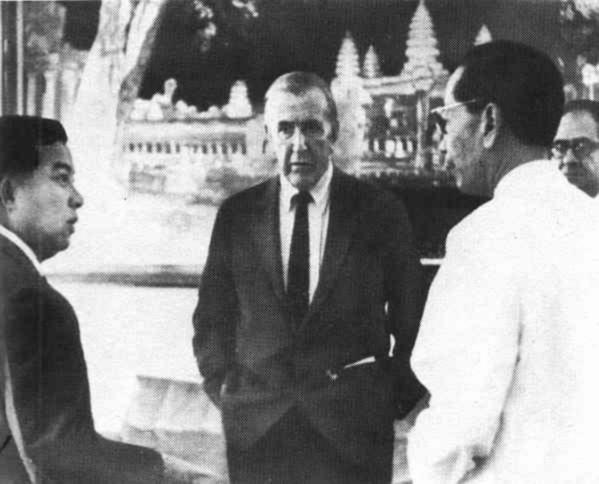
US envoy Chester Bowles
meets with Cambodian King Norodom Sihanouk (left)
and Premier Son Sann concerning
Communists' use of neutral Cambodia
to move men and supplies
south in support of the Viet Cong – January 1968
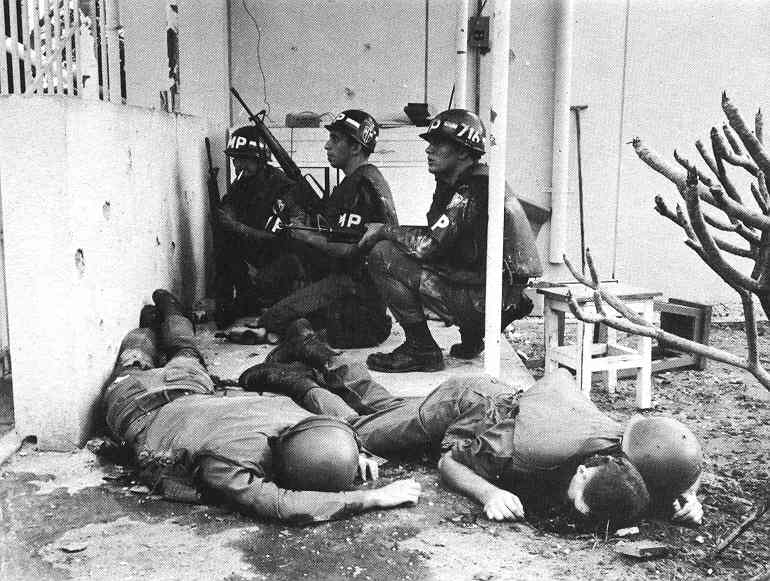
MP's returning fire from
inside besieged US Embassy in Saigon;
two dead US soldiers killed
during the surprise Viet Cong Tet attack – end of January 1968
The U.S. Embassy after the
Viet Cong Tet offensive – January 1968
US military casualties at Hue during the VC Tet offensive – January-February 1968
Street justice in Saigon during the
Tet Offensive
Viet Cong suspect Bay Lop seized
by South Vietnamese troops during the Tet offensive II
January 31,
1968
The suspect is brought to
the commanding officer, Brigadier General Nguyen Ngoc Loan
General Loan enacts "justice"
on the spot
(this picture would appear
widely in the US news
– horrifying Americans and stirring anti-war
fever)
After talking to the media General Loan casually walks off to take care of other business
A North Vietnamese soldier in battle at Hue during the Tet Offensive – 1968
Dead Viet Cong killed outside the
perimeter of the Tan Son Nhut Air Base
during the Tet Offensive (Feb. 1,
1968)
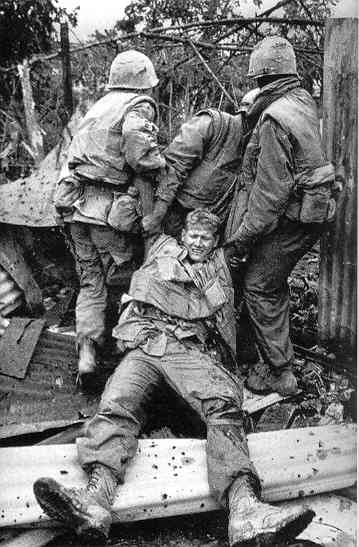
U.S. soldiers near Hue dragging
a wounded comrade to safety
Wearied troopers of the US
1st Cavalry Division taking a break in action near Hue – mid-March 1968
Khe Sanh, Vietnam – 1968 – US ammo dump exploding
Boomer kids now take up the anti-war crusade
"Hey, hey, LBJ ... How many
kids did you kill today?"
An anti-war protest in San
Francisco – 1968

|
|
Johnson decides to disappear (March)
Sickened by the failure of his Great Society to bring America to new social heights, but to have produced instead only deep racial conflict (and a lot of burned-out urban neighborhoods); worn out by the heavy criticism of the enormous military effort in Vietnam (with anti-war protesters gathered outside the White House to conduct non-stop campaigning, chanting "hey, hey, LBJ, how many kids did you kill today?"); feeling betrayed by his own generals who had been assuring Johnson that with over 500,000 American troops in Vietnam all was going as planned there; and now facing stiff criticism from even members of his own political party – Johnson, in concluding a March telecast to the nation, abruptly (and without any prior warning to the press) announced that he would not be running again for President in the elections coming up that November. He was bailing out, presumably leaving his extensive Great Society program and his all-absorbing anti-Communist stand in Vietnam for someone else to carry on (or not).
|
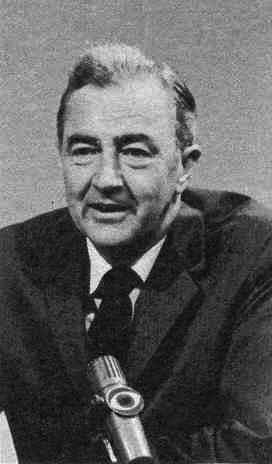
Sen. Eugene McCarthy – strong
anti-war voice as the Vietnam War cranked up – whose strong
showing in
the early 1968 Democratic Presidential primaries helped decide LBJ not
to run again
Johnson announces at the
end of a 45-minute TV broadcast that he will not seek reelection
March
31, 1968
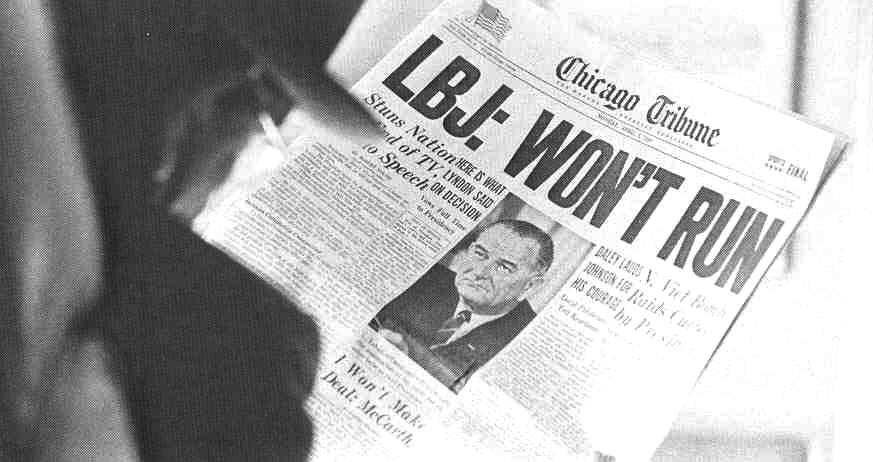
A stunned nation contemplates
LBJ's announcement

|
|
Then in April the nation was shocked by the
news that Martin Luther King had been assassinated while attending a
protest in Memphis Tennessee of garbage workers striking for better pay
and working conditions.1 Somehow the nation felt totally helpless despite these awkward displays of authority. What was happening to America? Was this how Dr. King would have wanted to be respected in death as in life? Who or what was behind all of this? Whites were blamed, of course. But that hardly answered the questions of a largely Liberal or Humanist America as to why now, why like this? What was happening to America? 1Seeing
his Black civil rights campaign radicalized by young Black Power
activists, King had recently switched his emphasis from race to
poverty, becoming more inclusive (supporting Whites as well as Blacks)
in his effort to improve the lot of poorer Americans. In fact, he was
planning a major "Poor-People's March on Washington" for that coming
June – very indicative of his new direction in the campaign for
American civil rights.
|
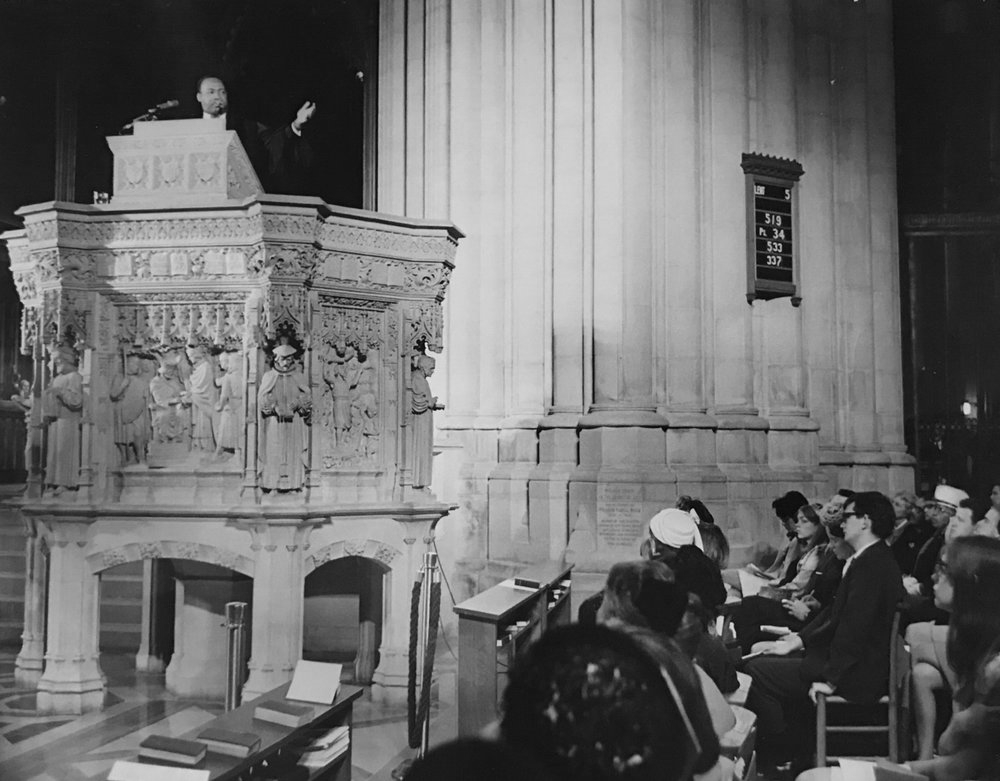
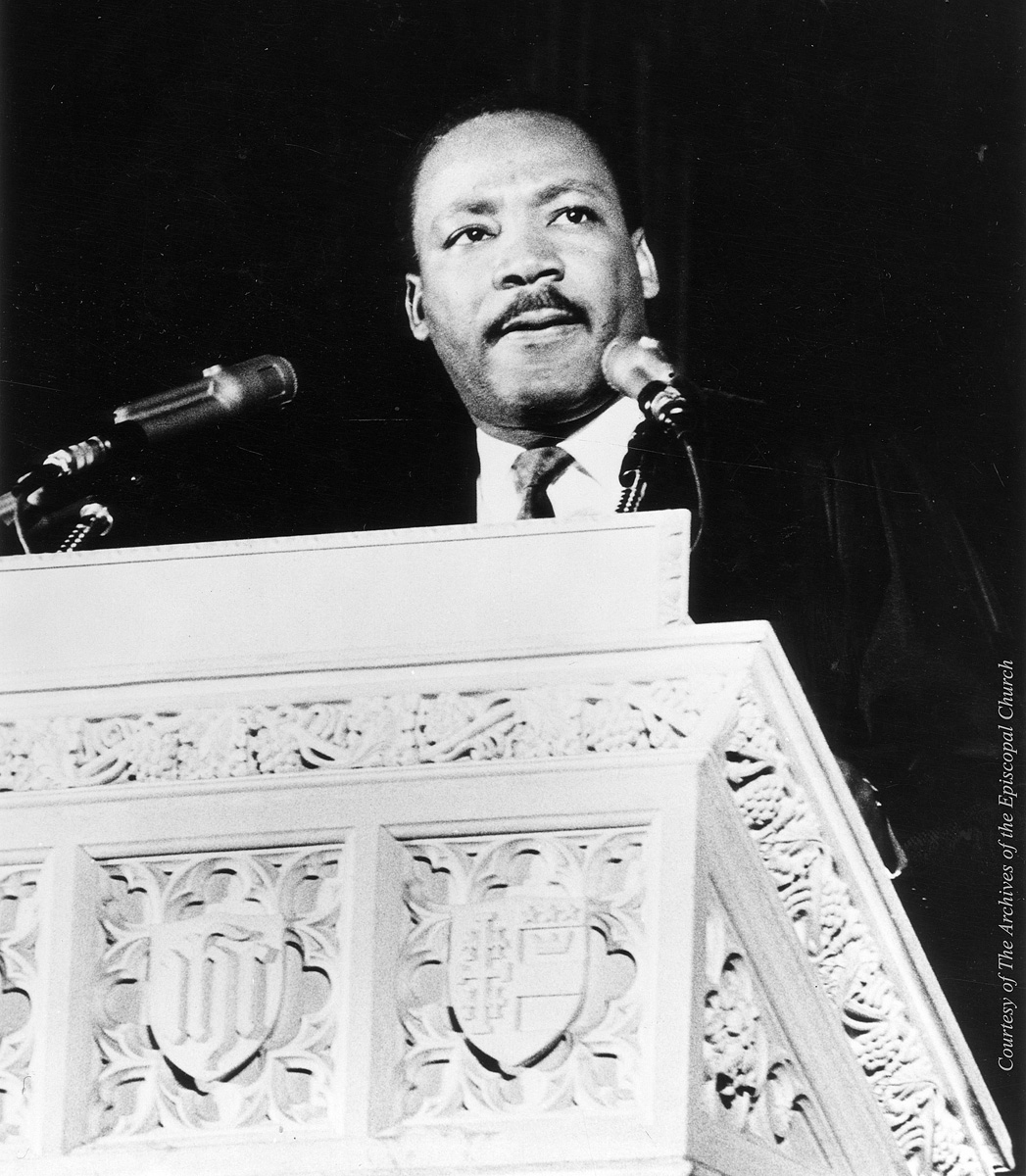
Most eerily (in retrospect), he spoke very prophetically about his focus on merely Black civil
rights being over (he was not going to be part of the Black Power takeover of the movement).
Little did he know how "over" that would be.
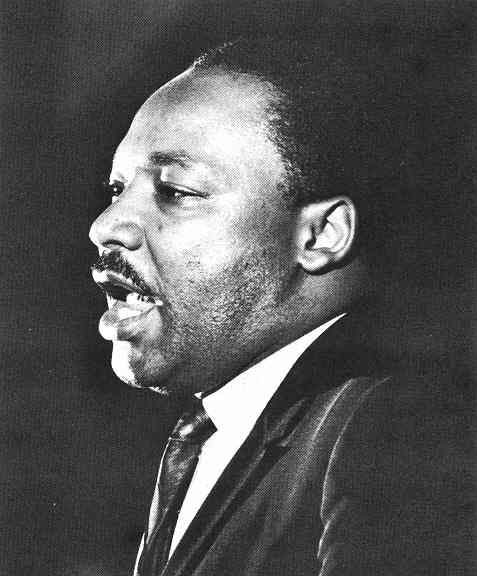
Dr. Martin Luther King, Jr.
during his last public appearance the night before his death – April
1968
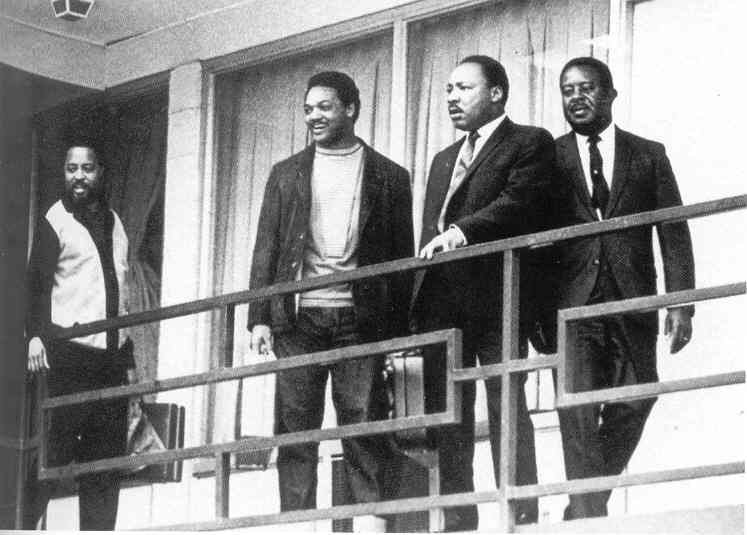
Dr. Martin Luther King on
the balcony where he would be shot on the following day
Rev. Dr. King's aides point
to where the sniper shot that killed King came from
Memphis, April 4,
1968
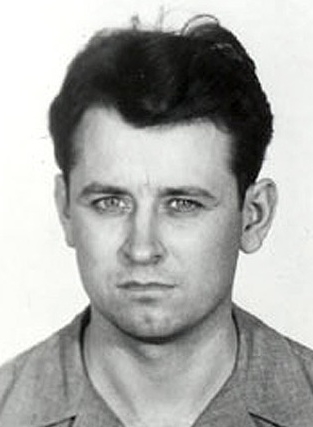
His assassin, James Earl Ray – a hard-core racist ... and prison escapee (1967)
earlier convicted of fraud, theft and robbery
Washington burning in the
wake of the assassination of Dr. Martin Luther King, Jr. – April 1968
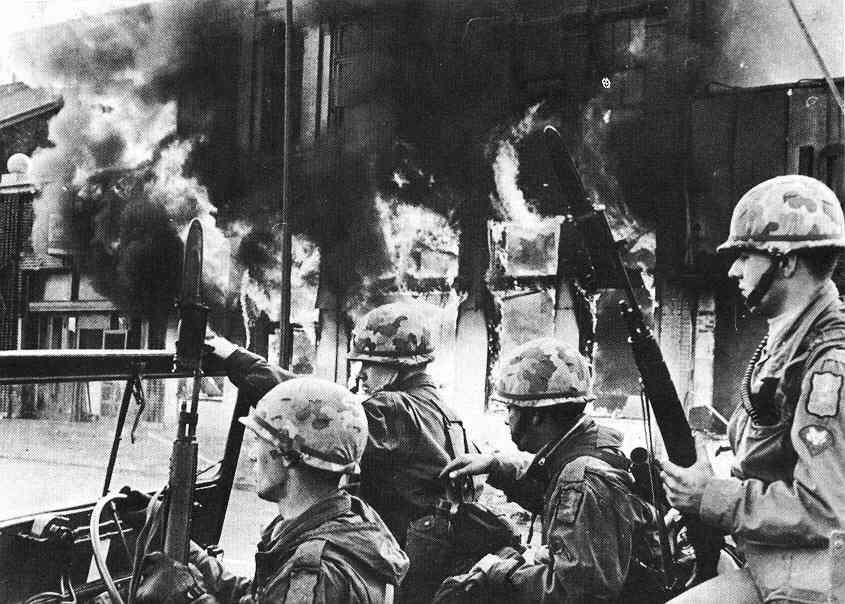
National Guardsmen patrolling a burning section of Washington, D.C. – April 1968
The nation's capital after the riots
Chicago burning in the wake
of Martin Luther King's assassination – April 1968
Mules bearing King's coffin
through the streets of Atlanta – April 1968
In tribute to King, a “Poor
People’s March” on Washington he had planned for that summer
went
ahead
in June as scheduled … though it sadly turned
into a muddy mess when
it rained every day. Spirits were way down,
especially when the effort seemed
to produce no new
advances in social or cultural programming
"Resurrection City":
A muddy encampment on the Washington Mall during
the Poor People's March – May 1968

|
With the assassination of
Dr. Martin Luther King, the youth began to challenge the opinion
of their
elders that America’s racial problems
were essentially a Southern phenomenon …
It was now traditional American
culture itself that was to blame.
…
and the older American generation was as fascist as Southern
racists
|
Campus upheaval at Columbia University
At the end of April, a strange event broke out on the Columbia University campus in New York City: students had taken over the administration building of the university and were trying to shut down the university (Maoist style), claiming that the university's expansion program demonstrated a racist insensitivity to Blacks living in the neighborhood. Conservative students hoping to go through graduation ceremonies in a few weeks and thus not wanting to see the University shut down, attempted to retake the university from the "Liberal" protesters gathered in and around the university. But the latter group continued to hold control of the university for what remained of the school year. Almost immediately this then became the inspiration for more of this type of Boomer heroics to break out across the country, even in Europe as well as in America. A bizarre cultural war of sorts was clearly looming.
|
A protest against Columbia
University's decision to build a gymnasium
in a Black neighborhood
in Morningside Heights
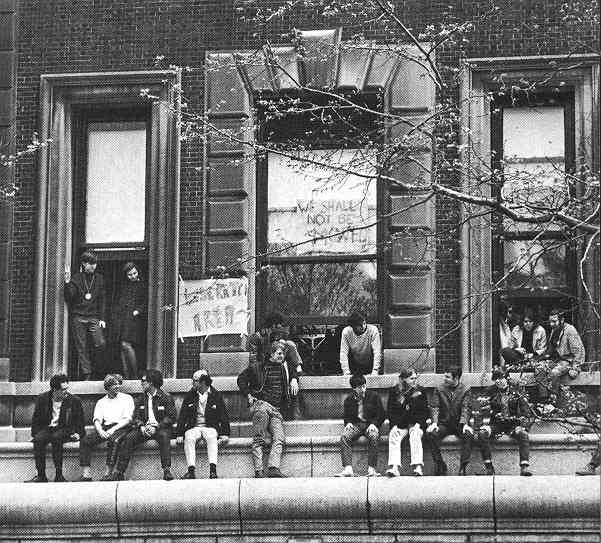
Columbia University students
occupying the Math building in protest against
the University's plans to build a new gymnasium on land owned by the university,
but while idle, used by the surrounding Black neighborhood for gardens
– April 27, 1968
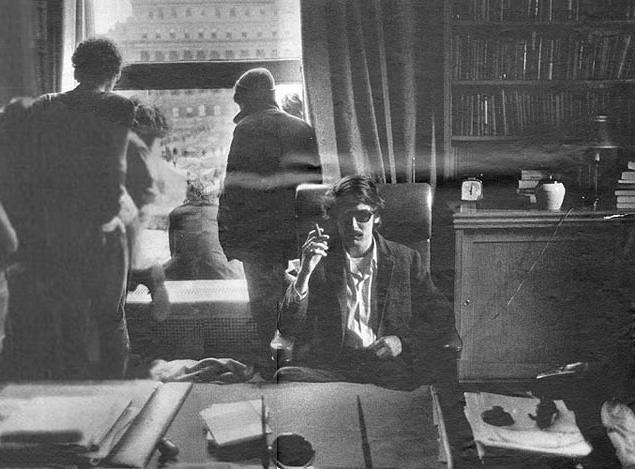
Students have taken over
the office of Columbia President Grayson Kirk – April 1968
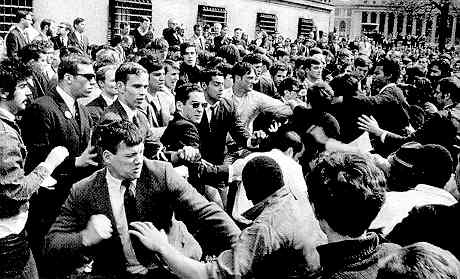
Hundreds of student
counter-demonstrators
taking on the SDS
("Students for a Democratic Society") radicals
With Columbia University
students having taken over the university,
a professor conducts outdoors
class
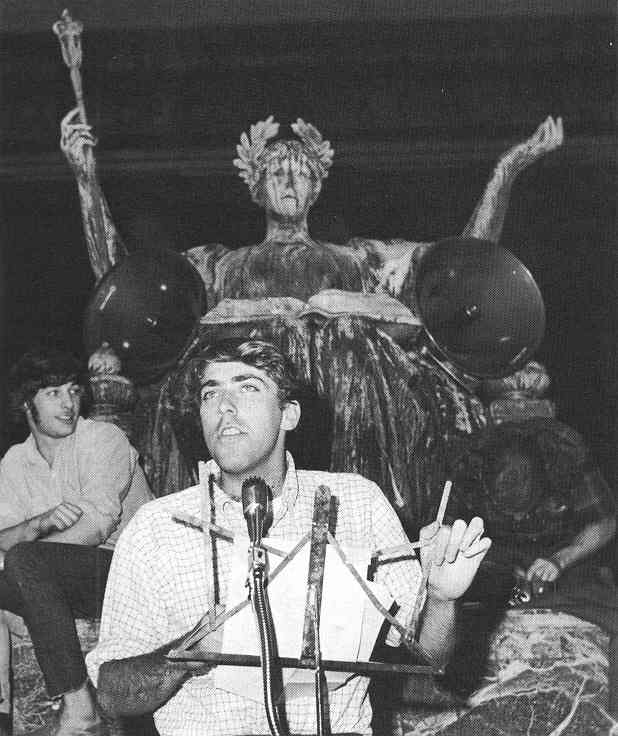
Columbia University strike
leader Mark Rudd in May
calling for demonstrations
to continue into the summer

|
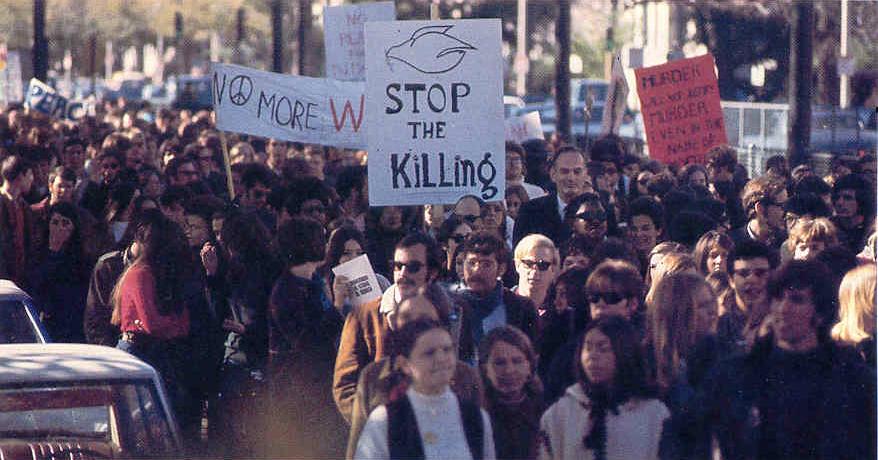
Anti-War
protest
Fr. Philip Berrigan (center),
his brother Fr. Daniel Berrigan (right) and others of
the "Catonsville
Nine" watch draft files from the
Catonsville, Maryland,
Selective Service Office being burned – May 17,
1968

|
Johnson signing the 1968
civil right act ending discriminatory housing in America – April 1968
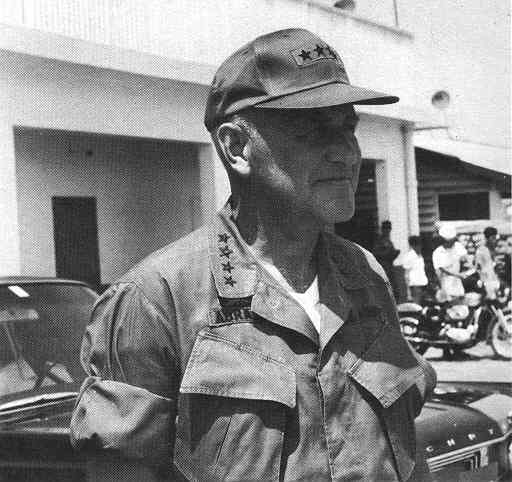
Gen. Creighton Abrams, who
replaced Gen. Westmoreland as commander
of the US forces in Vietnam – April
1968

|
|
In June another assassination struck, this time Robert Kennedy, who was clearly the front runner among the Democratic Party contenders for the Presidency, and thus very likely also to be the country's next President. The assassination was committed by a young Palestinian-American who appeared to have no particular motive for doing so.2 The assassination seemed so pointless, so tragic ... and left the nation profoundly stunned.
2It would eventually be revealed that the assassin, Sirhan Sirhan – who had come to America when he was twelve – was angry at Kennedy's support of the decision to send 50 bombers to the Israeli air force. As a child, he had witnessed an Israeli tank run over his older brother, and was very bitter towards Israel as a result.
|
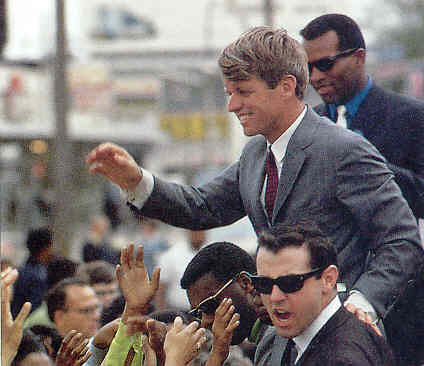
Bobby Kennedy stumping for
the Democratic Party presidential nomination – 1968
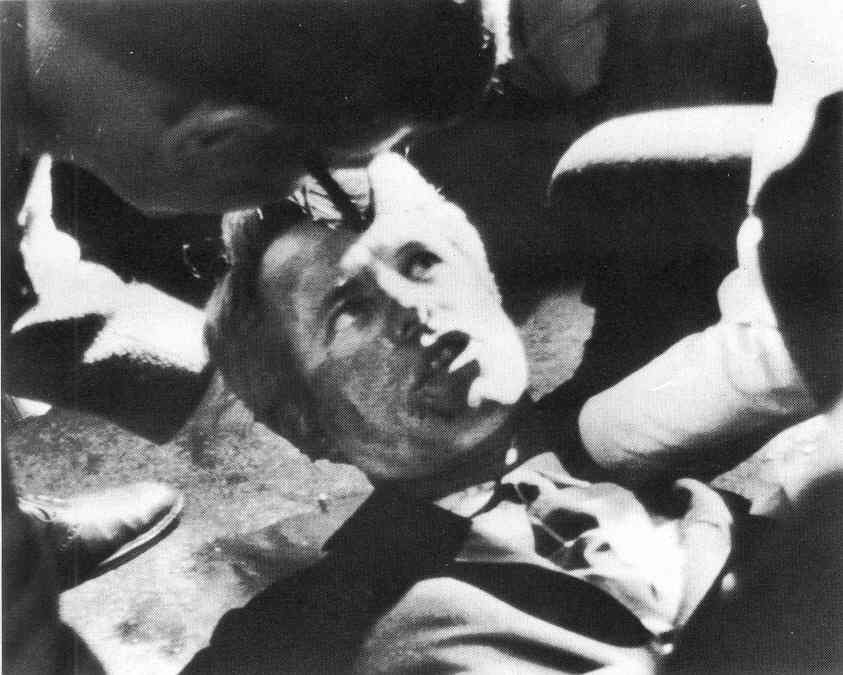
Bobby Kennedy shot at the
Ambassador Hotel in Los Angeles – June 5, 1968
Bobby Kennedy shot – June 1968
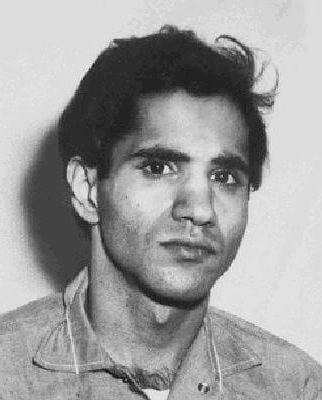
Kennedy's assassin: Sirhan Sirhan

|
A North Vietnamese Soviet-built Surface-to-Air Missile (SAM)
Aircraft spraying Agent Orange to defoliate the forests that shelter the Viet Cong (pure evil!)
The Effects of the defoliant Agent Orange

Also ... the effects on the next generation raised on food
grown in the ground attacked with Agent Orange
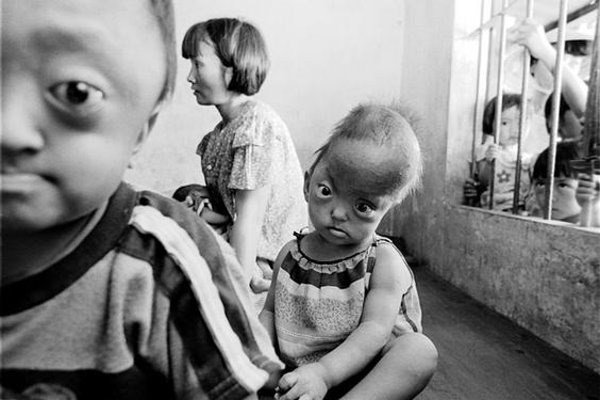
The Viet Cong seem to be unbending in their resistance efforts
North Vietnamese President
Ho Chi Minh (left) and Prime Minister Pham Van Dong
– November 1968
(Ho Chi Minh died the following
September)
President Lyndon Johnson
listens to a tape recording from his son-in-law Capt.
Charles Robb, who was a
Marine Corps company commander in Vietnam

|
All eyes are turned to the
Republican and Democratic Party National Conventions –
to see what might emerge
as a ray of hope
|
In contrast to the Republican Party National Convention in Miami, which fairly calmly gathered in early August to nominate Richard Nixon as the Republican presidential candidate, Democrats assembled in Chicago later that month surrounded by a very turbulent and even violent world. |
The Republican National Convention
– August 5-8
The Republicans choose Nixon
and a tough Maryland Governor
symbolizing a stiffer
response to the chaos that gripped America
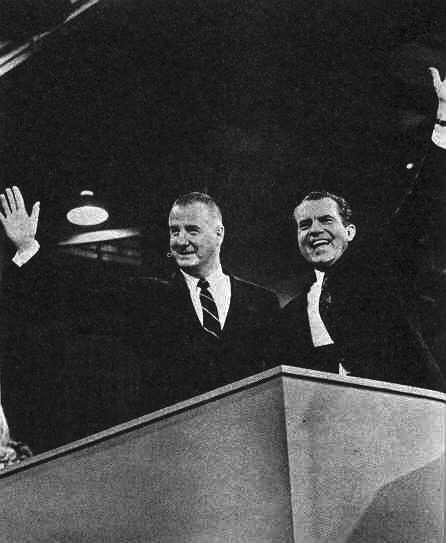
Richard Nixon and Spiro Agnew
nominated as Republican
Presidential and Vice-Presidential candidates -
August1968
The Democratic National Convention was a study in catastrophe
|
The Democratic Party's National Convention (August)
Indeed, as the Democratic Party gathered in Chicago in August to nominate a presidential candidate, the convention became itself the scene of ugliness both inside and outside the convention hall. Hippie (even more radical "Yippie") Boomers had come in from all around the country to protest the war, protest racism, protest basically anything that held sway as the patriotic ideal of the older Vet generation. Chicago Mayor Daley had prepped the police for a tough confrontation with these "unpatriotic" youth, and the Boomers were prepped to confront these "Fascist pig" police with their own brand of militant action. Both groups wanted a war. Both groups got their war. For a while, Chicago authorities lost control of events in and around the convention center as bystanders, journalists, even delegates attempting to come or go at the convention were beat up, mostly by rioting Chicago police. The nation watched on their TV's as the violence mounted, and as Mayor Daley conducted a foul-mouth campaign of his own inside the convention hall. What an appalling sight. What was happening to America?
|
Anti-war demonstrators gathering
before the Democratic National Convention in Chicago
August 1968
Pigasus, the Yippie presidential
nominee seized by Chicago police
prior to the opening of
the Democratic National Convention – August 1968
Protesters hurling back tear
gas at the Chicago Police – August 28, 1968
Then the police seem to "lose it" and themselves turn
riotous
The Chicago Police charging
the demonstrators at the Grant Park flagpole – August 28, 1968
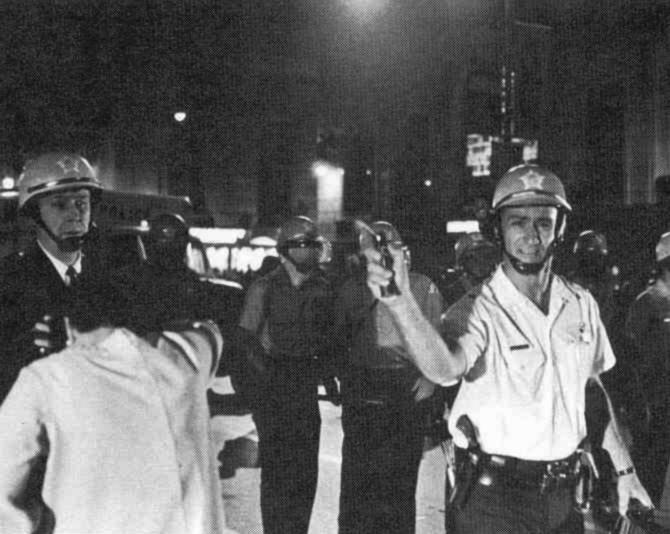
Chicago policeman macing
a press photographer
after having maced the woman
to the left outside the convention hall – August 1968
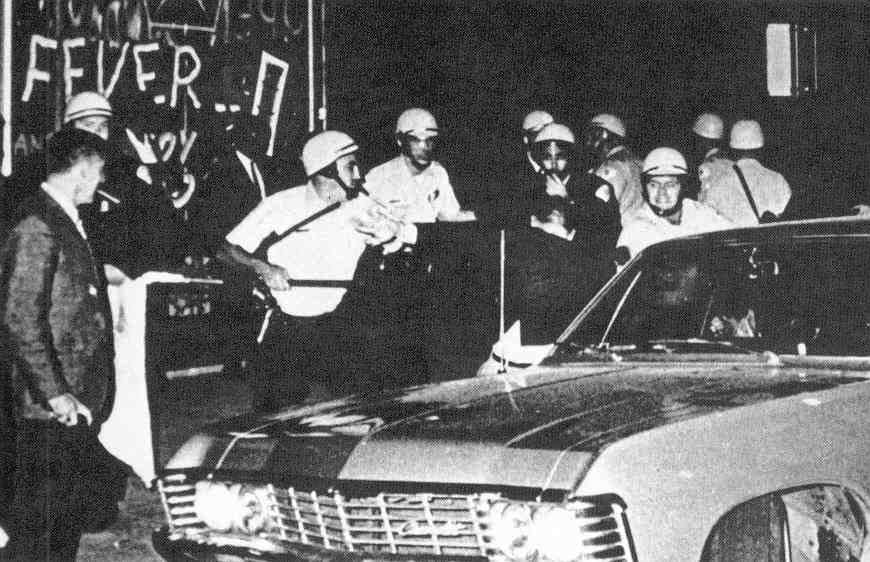
Chicago police attacking
a newsman who had just complained
about their treatment of
some young people in a car – August 1968
John Evans of CBS News, himself
wounded by rioting Chicago police,
interviews another victim – 1968
Senator Abraham Ribicoff
and Chicago Mayor Daley squaring off at the Democratic
National Convention about
the tactics of the Chicago police
(Daley's shouted response:
"F... you, you Jew son of a b....")
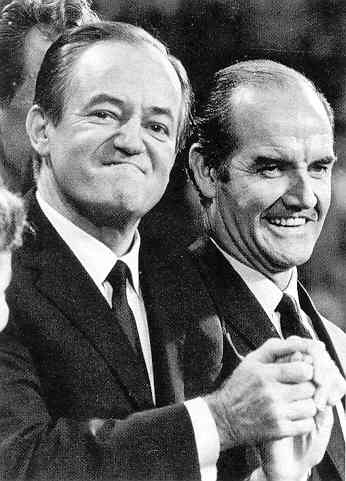
Hubert H. Humphrey and his
defeated rival George McGovern at the Democratic National
Convention

|
September 7, 1968 – about
400 feminists gather in Atlantic City to protest the Miss America
Pageant, trashing bras, high heels,
cosmetics and briefly putting a fire to the trash
bin (but quickly put out by
the police) ... starting the talk about feminist "bra burning"
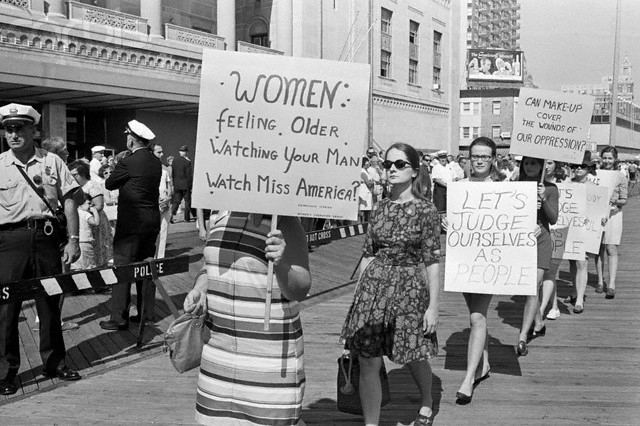
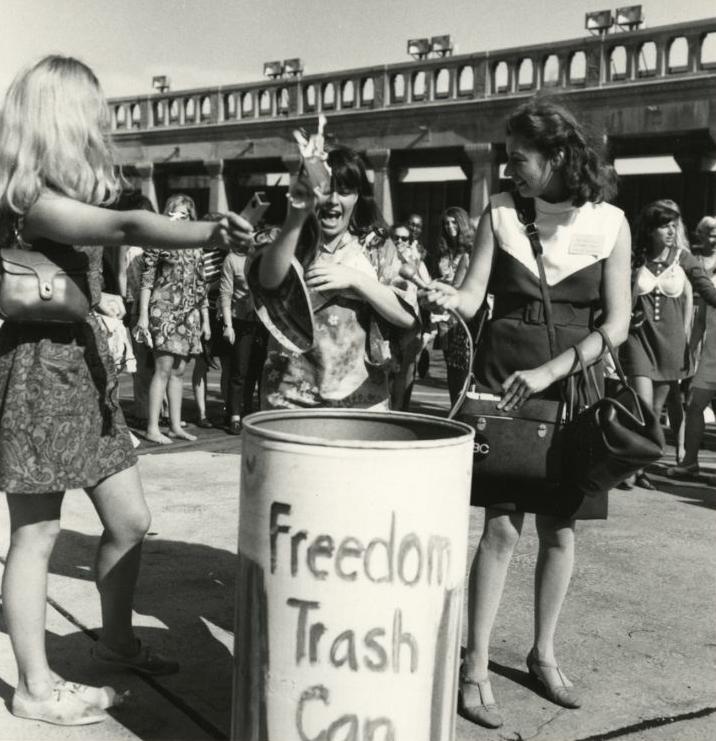
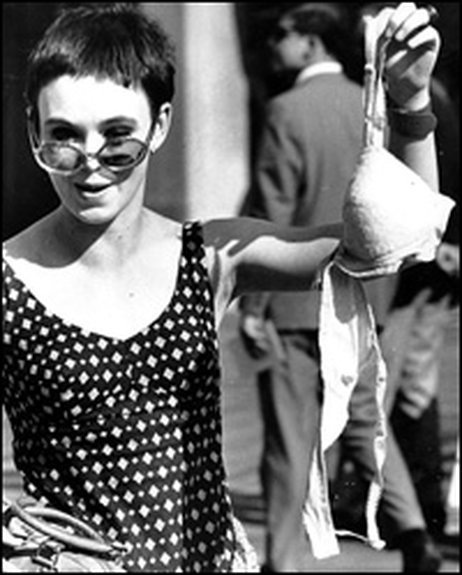
The idea catches hold and
grows as a sign of their "freeing" themselves
from society's expectations
of them as women
A demonstrator removes her
brassiere during an anti-bra protest
outside a San Francisco department
store.

|
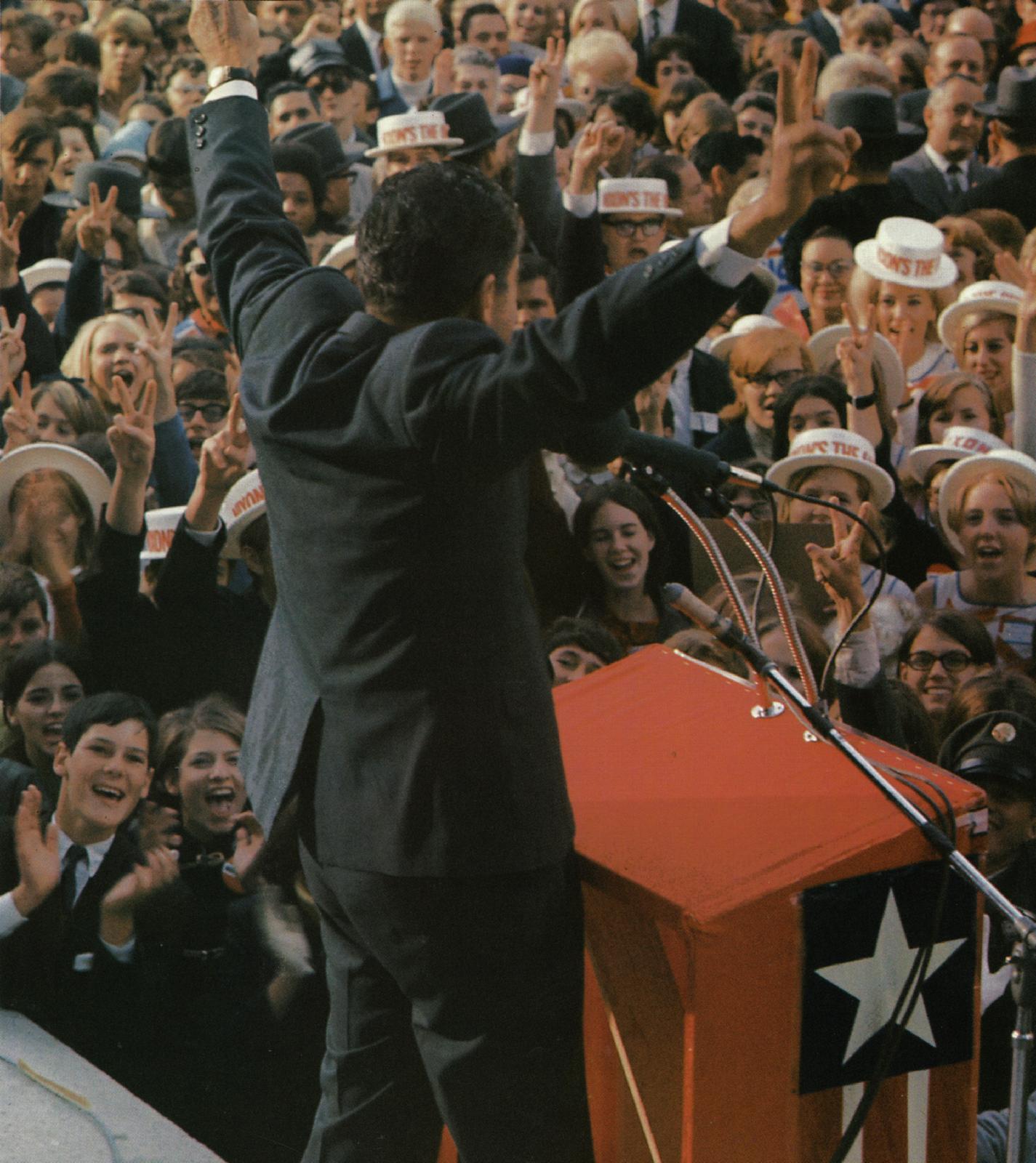
Nixon flashes "V' for victory
sign at a Republican campaign rally in Ohio – October 1968
(the anti-Nixon press loved
to lampoon this Nixon gesture)
|
The November 1968 elections: Nixon to the White House
In the meantime, the Republican Party had gathered (earlier in August) in a much calmer setting in Miami to nominate Richard Nixon as their presidential candidate. Joining him on the Republican ticket as the Republicans' Vice-Presidential nominee was Maryland Governor Spiro Agnew, brought to recent political celebrity status when he publicly issued the threat that the violence of Black rioting would be met head on by equally rough police countermeasures. His threat was convincing enough that Baltimore, Maryland, was one of the few major American cities that did not undergo the bath of fire administered in the name of "Black power." With the Democrats in such disarray, with the Vet voters hungry to get someone into the White House that they could trust to get America back in order, Nixon upset the Democrats' expectation for an easy win for their presidential nominee, the rather academic Hubert Humphrey, a former U.S. Senator serving the past four years as Vice President. Also the third-party run of Alabama governor George Wallace cut deeply into the reliably Democratic Party vote of the South (which actually however would soon be moving rapidly into the Republican Party camp). The popular vote favoring Nixon was a close one with Nixon drawing 43.4 percent of the popular vote to Humphrey's 42.7 percent (Wallace with 13.5 percent), although the electoral college vote was strongly in Nixon's favor 302 to 191 (Wallace with 46). The Boomers, and their intellectual mentors (professors, journalists, and "Liberal" politicians), looked on in horror as the Vets' champion, but almost by instinct the intellectuals' Public Enemy Number One, was about to take residence in the White House.
|
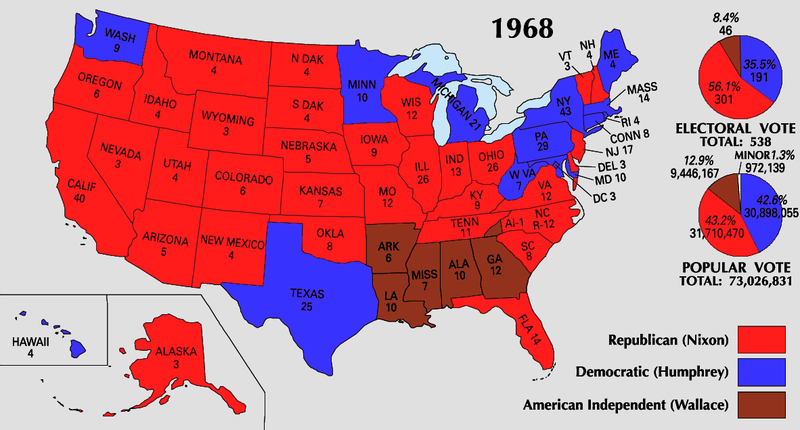
The 1968 presidential election
 Miles
H. Hodges
Miles
H. Hodges